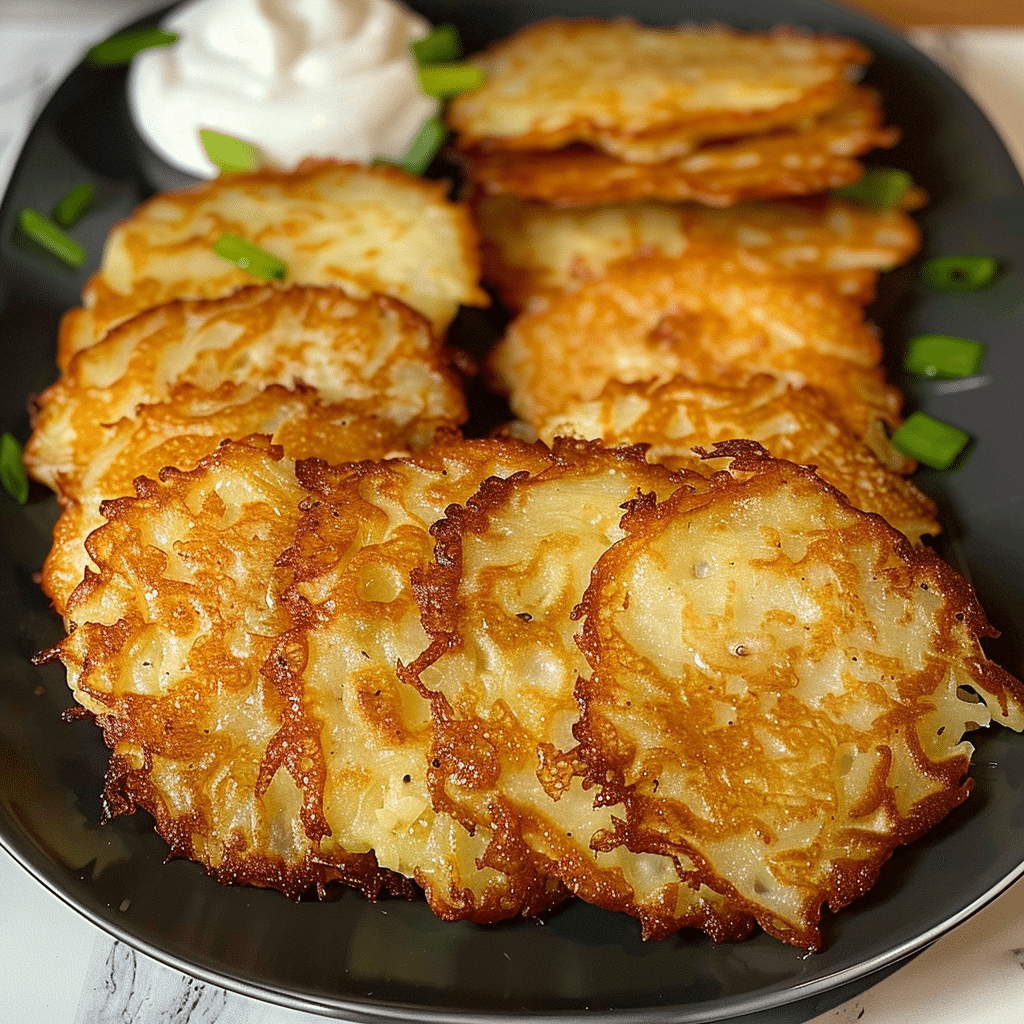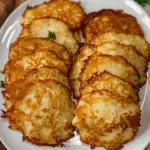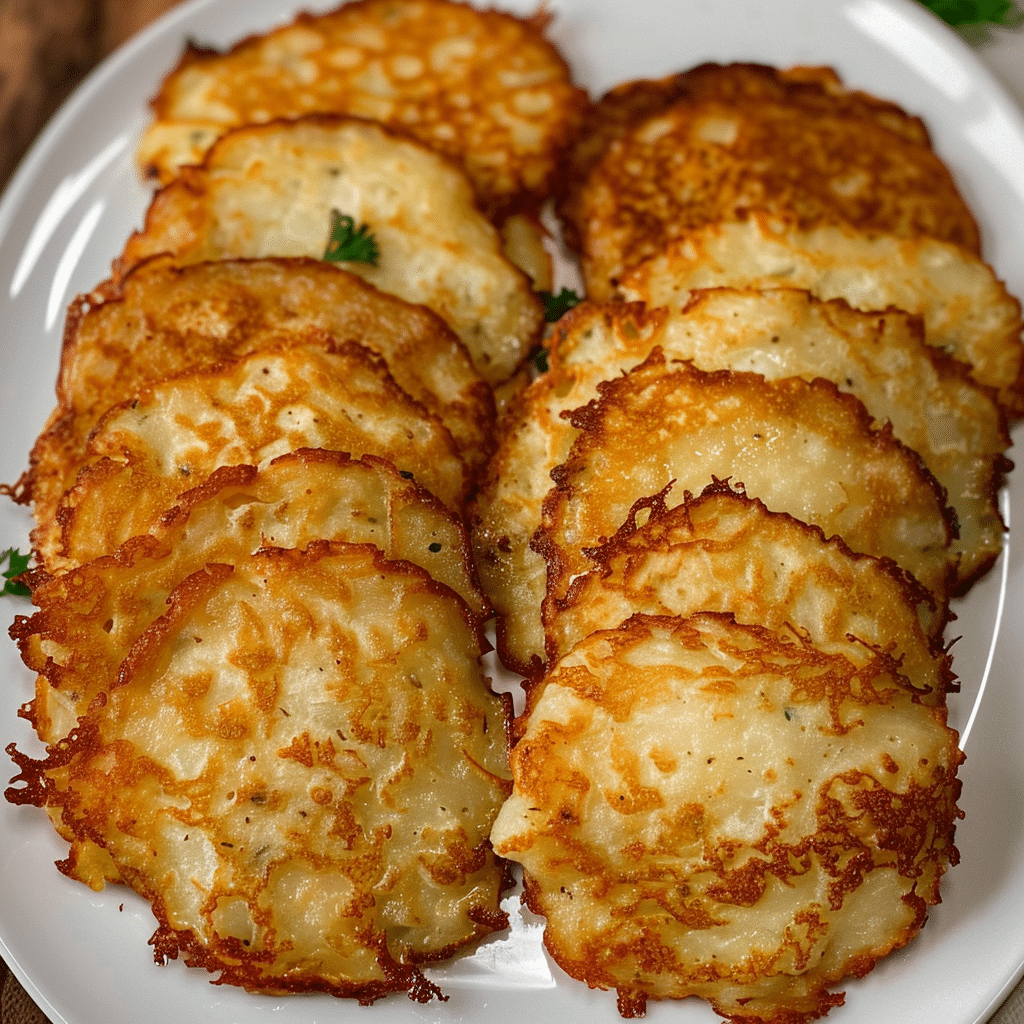German Potato Pancakes are easy to make at home, delivering crispy edges and a tender interior every time. You will learn the classic grating and frying techniques for perfect results.
German Potato Pancakes are the perfect savory treat for any time of year. You can easily master this traditional recipe in your own kitchen. It all begins with properly grating the potatoes and onions to create the ideal texture. This classic dish, often called Kartoffelpuffer, is known for its signature golden color and satisfying crunch. Serve them immediately with your favorite sweet or savory toppings for the best flavor.
Key Takeaways
- Achieve maximum crispiness by draining the liquid from the grated potatoes.
- Flatten the pancakes slightly during frying to ensure they cook evenly.
- A quick second fry step provides that signature, extra-crunchy texture.
- Serve immediately with applesauce or sour cream for a perfect contrast.

German Potato Pancakes are traditionally made by grating raw potatoes and onions, then binding them with a little flour and egg. You will then shallow-fry the mixture until it is perfectly golden brown and crispy on the outside. This quick process yields a delicious, tender interior and makes them ideal for appetizers or a comforting side dish.
Basics of German Potato Pancakes
German Potato Pancakes are often associated with special occasions, but they are simple enough for everyday cooking. You will appreciate how few ingredients are required to create such a flavorful and satisfying dish. The technique is key here, specifically how you prepare and handle the raw potato mixture before it hits the hot oil. Knowing these steps will guarantee your success.
Choosing the Right Potato Type for Latkes
You should always choose starchy potatoes, like russets, for making German Potato Pancakes. Starchy potatoes break down well and release the necessary starches to help bind the mixture naturally. This selection prevents your pancakes from crumbling apart when you are frying them. Avoid waxy potatoes, as they tend to hold too much moisture, which results in soggy pancakes.
The Importance of Grating and Draining Potatoes
Grating the potatoes with the large side of a box grater provides the best consistency for the batter. You want strips that are chunky enough to hold their shape but small enough to cook quickly. Most importantly, you must squeeze out as much excess liquid as possible after grating. Too much moisture is the main culprit behind soft, non-crispy pancakes.
Preparing the Perfect German Potato Pancakes Batter
The batter preparation is a straightforward process that determines the final texture and taste of your pancakes. You need to work fairly quickly once the potatoes are grated, as they will start to oxidize and turn brown. Have all your other ingredients measured and ready to go before you begin grating. This speed helps maintain the vibrant, fresh potato color.
Mixing in Onion, Flour, and Egg for Binding
You will add a small yellow onion, grated, right along with the potato mixture for flavor. Next, you mix in a pinch of salt and pepper, three tablespoons of all-purpose flour, and one large egg. The egg and flour act as the necessary binding agents to hold the grated potatoes together during frying. Use your hands to thoroughly combine these components, ensuring a thick, cohesive batter.
Seasoning Tips for Flavorful Potato Pancakes
You can adjust the seasoning to match your preference for sweet or savory German Potato Pancakes. For a savory profile, don’t be shy with the black pepper and an extra pinch of salt. If you plan on serving them with sweet toppings like applesauce, you might omit the pepper entirely. For more ideas, you can check out this article on flavorful main course options.
Mastering the Frying Technique for Optimal Crunch
Frying these pancakes is where you transform a simple batter into a culinary masterpiece with a beautiful crust. You need to use enough oil, but not so much that the pancakes become greasy. The temperature of the oil is also crucial for developing that rich, golden-brown exterior. Do not overcrowd the pan, as this lowers the oil temperature quickly.
Selecting the Best Oil and Skillet for Frying
You should use a neutral vegetable oil that has a high smoke point, such as canola or sunflower oil. A heavy-bottomed skillet, like cast iron, works best because it maintains a consistent temperature across the surface. Heat one to two tablespoons of oil over medium heat; you should hear a sizzle when the batter is added. This sizzle indicates the perfect temperature for crisping.
The Double-Fry Secret to Extra Crispy Pancakes
The secret to truly crispy German Potato Pancakes is a quick, final double-fry. Once all the pancakes have been cooked for three to four minutes per side, you refry them in the hot oil. This second frying pass only takes about 30 to 60 seconds per side, and it dramatically increases the crunch factor. This step is what separates a good pancake from a great one.
Common Mistakes to Avoid When Making Potato Pancakes
You can easily achieve perfect results by avoiding a few common pitfalls that can lead to disappointment. Primarily, problems arise from too much moisture or incorrect frying temperature. Paying close attention to the batter’s consistency and the oil’s heat will solve most issues. You are aiming for a potato mixture that holds together without feeling watery.
Preventing Soggy Pancakes by Removing Excess Water
You must remember that not draining the liquid is the number one cause of soggy pancakes. After grating, let the mixture sit for a few minutes and then firmly press or wring out the excess water. The resulting batter should feel moist but not wet. For more details on the importance of moisture control in cooking, review this Wikipedia article on Shallow Frying.
Maintaining Consistent Frying Temperature
You must keep the oil at a medium, consistent temperature throughout the cooking process. If the oil is too cold, the pancakes will soak up the grease and become oily. If it is too hot, the outside will burn before the inside has a chance to cook completely. Cook them in batches to help keep the pan temperature even.
Serving and Topping Your German Potato Pancakes
German Potato Pancakes are best when served immediately while they are still hot and perfectly crispy. You can keep batches warm in a low oven, but they should be served as soon as possible after the final fry. The contrast between the hot, crunchy exterior and the cool topping is a delightful pairing that enhances the experience.
Traditional Sweet Toppings: Applesauce and Sugar
The most classic and traditional topping in Germany is often a sweet one, primarily applesauce (Apfelmus). The slight sweetness and soft texture of the applesauce pair wonderfully with the salty, crisp potatoes. A dusting of brown sugar is also a simple, popular choice that you can add easily before serving.
Savory Options: Sour Cream and Yogurt Sauce
You may also prefer a savory pairing, with sour cream being the most common choice. A dollop of sour cream or a simple yogurt sauce adds a cool, tangy contrast to the rich fried flavor. Consider adding chives or a sprinkle of paprika to your sour cream for an extra layer of flavor. This savory side is perfect when you serve them as part of a meal, perhaps with a side of traditional soups and stews.
Comparing German and Other Potato Pancake Varieties
You will find that potato pancakes are a beloved dish in many cultures, often with slight variations in ingredients or preparation. While the basic concept of grated potato and frying remains, the binders and typical serving methods can differ. Understanding these variations helps you appreciate the uniqueness of the German version. This type of comparison highlights the small, important changes in regional cooking.
Latkes vs. Kartoffelpuffer: Subtle Differences
The primary difference between the Jewish latke and the German Kartoffelpuffer (potato pancake) is often the binder. Latkes sometimes use matzo meal, while the German version typically uses all-purpose flour. You will also find that the German version often incorporates grated onion more liberally than other regional varieties. Both are essentially delicious, shallow-fried potato cakes.
Regional German Potato Pancake Variations
You should know that even within Germany, potato pancakes have regional differences, such as the use of leeks or other vegetables in the mixture. In some regions, they are served thinner and crispier, while others prefer a thicker, more cake-like consistency. No matter the variation, the crispy, comforting texture remains the key component that people love. You can also explore Rösti for another great potato preparation.
Tips for Storing and Reheating Potato Pancakes
You might find that you have leftovers, and properly storing them is key to enjoying them later. The goal is always to restore that delightful crispiness when you reheat them. Storing them correctly prevents them from becoming a soft, damp mess in your refrigerator. You will want to avoid using the microwave for reheating at all costs.
Best Methods for Reheating to Maintain Crispiness
You should always reheat German Potato Pancakes in a dry skillet over medium heat or in a toaster oven. A conventional oven heated to 350°F (175°C) also works very well, taking about 10 minutes to reheat. These methods ensure the exterior has a chance to crisp up again, reviving the original texture. Avoid covering them during reheating to let the moisture escape.
Serving German Potato Pancakes as an Appetizer
These pancakes make an excellent appetizer because they are easy to hold and can be prepared ahead of time. You can make them in a smaller size, perfect for dipping or stacking a variety of toppings. They are hearty enough to satisfy without being overly filling before the main meal. They also pair well with a wide range of beverages.
Pairing Pancakes with Other German Appetizers
You can create a wonderful spread by serving these crispy pancakes alongside other German-inspired appetizers. A small side of cold cuts or a hard cheese makes a wonderful contrast to the hot, savory potato cake. You might consider serving them with a dipping sauce, such as a herbed aioli, to complement the flavor.
The Cultural Significance of Kartoffelpuffer
You should know that the Kartoffelpuffer holds a special place in German culinary culture, often appearing at holiday markets and festivals. They are a dish of comfort and tradition, representing simple, hearty cooking. The preparation often brings families together, especially around Christmas markets or other winter celebrations.
Quick Side Dishes to Serve with Potato Pancakes
You can turn these pancakes into a full meal by serving them with simple, flavorful side dishes. Since the pancakes are already quite rich, opt for lighter, contrasting sides. A fresh salad or a simple vegetable preparation is often the perfect complement. For more ideas, visit the side dishes category.
German Potato Pancakes: A Look at Different Topping Combinations
You have many creative options beyond the traditional applesauce and sour cream. Consider smoked salmon and dill cream cheese for a luxurious topping. Alternatively, a sprinkle of freshly chopped scallions and a dash of hot sauce offers a spicy kick. The crispy base is versatile and holds up to virtually any flavor you decide to use.
German Potato Pancakes are a delightful recipe that you can easily recreate in your kitchen for an authentic taste of Germany. You learned that the key to achieving that signature crunch is properly draining the grated potatoes and using the double-fry method. Whether you choose a sweet or savory topping, these crispy potato cakes are sure to become a favorite in your home. Remember to share your favorite variations on Pinterest and Instagram; we love seeing your culinary creations!
German Potato Pancakes are a wonderful tradition to bring into your home, offering a simple, satisfying meal or appetizer. You have all the techniques and tips needed to ensure your pancakes are perfectly crispy and golden every time. Enjoy the process of creating this delicious, comforting food and the joy it brings to your table.
Print
German Potato Pancakes
- Total Time: 30minutes
Description
Experience the hearty flavors of Germany with these mouthwatering German Potato Pancakes! Crispy on the outside, tender on the inside, they’re the perfect comfort food.
Ingredients
For the Pancakes
- 1 lb russet potatoes
- 1 small yellow onion
- Pinch of salt plus more for seasoning
- Pinch of black pepper for savory pancakes
- 3 tbsp all-purpose flour
- 1 large egg
- Vegetable oil for frying
Instructions
- Wash and peel the potatoes. Grate them into a bowl using the large grating side of a box grater. Grate the onion into the same bowl.
- If there is excess liquid pooling in the potato mixture, drain off as much as possible.
- Add the salt, pepper (if making savory pancakes), flour and egg to the potato-onion mixture. Use your hands to thoroughly mix everything together into a thick batter.
- Heat 1-2 tbsp vegetable oil over medium heat in a large skillet. For each pancake, scoop about 2 tbsp of the potato batter into the hot oil, flattening slightly with the back of a spoon or spatula.
- Fry the pancakes for 3-4 minutes per side until deeply golden brown and crispy on both sides. Transfer to a paper towel-lined plate.
- Once all the pancakes are fried once, re-fry them one more time for 30-60 seconds per side for extra crunch.
- Serve the potato pancakes immediately while hot and crispy. Top with applesauce, brown sugar, sour cream, yogurt sauce or any other desired toppings.
Notes
Enjoy these crispy, nostalgic German potato pancakes piping hot for the ultimate treat! Let me know if you need any other tips to make them as authentic and delicious as possible.
- Prep Time: 10minutes
- Cook Time: 20minutes
Nutrition
- Serving Size: 8 Pancakes
Keywords: German Potato Pancakes, Kartoffelpuffer, Latkes, Crispy Potato

